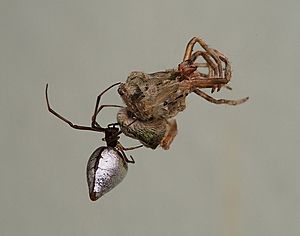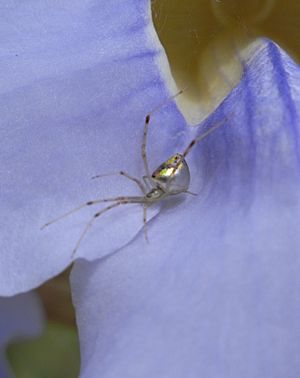Dew drop spider facts for kids
Quick facts for kids Dew drop spider |
|
|---|---|
 |
|
| Scientific classification | |
| Synonyms | |
|
Argyrodes antipodiana O.P-Cambridge,1880 |
The Argyrodes antipodianus, also known as the dew drop spider, is a tiny spider. It belongs to the cobweb spider family. You can find these spiders in Australia, New Zealand, and New Caledonia. They are special because they are "kleptoparasitic." This means they steal food from other spiders!
Contents
Discovering the Dew Drop Spider
The dew drop spider was first described in 1880. A scientist named Octavius Pickard-Cambridge gave it its scientific name. He studied samples from Sydney and New Zealand. Later, in 1917, another scientist, Raymond de Dalmas, updated its description. He also changed its name slightly to A. antipodianus.
What Does It Look Like?
Dew drop spiders are very small. They are usually only about 2 to 3 millimeters long. That's about the size of a small ant! Their bodies can be a bit different in size depending on if they are male or female.
Their head and legs are a dark brown color. But their abdomen, which is the back part of their body, is a bright, shiny silver. This shiny silver color is why they are called "dew drop spiders." It looks like a tiny drop of dew! Their abdomen also has a cool cone shape.
Where Do They Live?
You can find dew drop spiders in eastern Australia, New Caledonia, and most of New Zealand. However, they don't live in the southern part of New Zealand's South Island. Scientists think this is because they prefer warmer places to live.
How Do They Behave?
Dew drop spiders have a very interesting way of life. They live on the webs of much larger spiders. These larger spiders are often orb-weaver spiders. The dew drop spiders have a "kleptoparasitic" relationship with them. This means they are "food thieves"!
While living on the host spider's web, the dew drop spider steals small pieces of food. They often take prey that the larger spider has caught. This can be bad for the host spider. For example, one study looked at dew drop spiders living on the webs of Nephila plumipes spiders. The study found that the Nephila plumipes spiders grew slower. They also had to move their webs more often when dew drop spiders were stealing their food.
The host spider might try to kill the dew drop spider if it notices it. To stay safe, the dew drop spider builds its own "support web." This special web helps the dew drop spider move around without the host spider feeling it. With their support webs, they can move almost anywhere. They can steal food bundles. Sometimes, they even eat the prey at the same time the host spider is eating it!
Spiders They Live With
Here are some of the larger spiders that dew drop spiders are known to live with and steal from:
- Araneus dimidiatus
- Argiope
- Cyrtophora
- Cyrtophora hirta
- Cyrtophora moluccensis
- Eriophora transmarina
- Eriophora pustulosa
- Gasteracantha
- Leucauge
- Nephila plumipes
- Nephila pilipes
- Nephilengys
- Plebs eburnus


